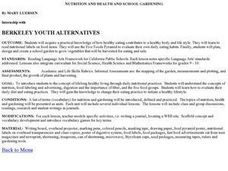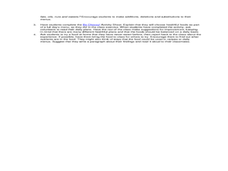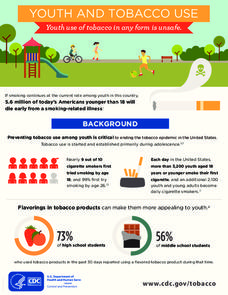Core Knowledge Foundation
The Human Body—Building Blocks and Nutrition Tell It Again!™ Read-Aloud Anthology
A read-aloud anthology explores the human body. Over three weeks, second graders listen to and discuss texts related to the cells, tissue, organs, digestive system, excretory system, nutrients, and a balanced diet. Learners practice word...
Curated OER
Nutrition and Health and School Gardening
Students examine how healthy eating contributes to a healthy body and life style. They read nutritional labels on food items. They use the Five Foods Pyramid to evaluate their own eating habits. They plan, design, and create a school...
Curated OER
Healthful Living
Third graders take digital pictures of people in healthful activities. In this technology health lesson, 3rd graders use their digital pictures to create a healthy living multimedia presentation.
Curated OER
A Balanced Diet
Students determine which healthy foods comprise a well balanced meal. Using a checklist, students classify foods as healthy or unhealthy. This instructional activity is intended for students acquiring English.
Curated OER
Mystery "F & V's"
Fourth graders explore agriculture by reading assigned text about produce. In this fruits and vegetables lesson, 4th graders identify the healthy benefits of consuming fresh produce and what minerals and vitamins they contain. Students...
Curated OER
Eating to Win
Learners examine human health by completing a sports nutrition worksheet. In this eating habits lesson, students discuss the importance of a balanced diet and proper feeding times when competing in physical activities. Learners complete...
Curated OER
How Do Foods Help Our Bodies
Students investigate the specific elements found in food that keep us healthy. For this healthy eating lesson, students identify proteins, carbohydrates, minerals, and vitamins as part of a healthy diet when consumed in moderation....
Curated OER
Calorie Countdown
Fourth graders explore human health by identifying calories in food items. In this healthy eating habits lesson, 4th graders view the USDA food pyramid on the Internet and identify the choices they should be making each day. Students...
Curated OER
Label Language
Sixth graders explore healthy eating habits by identifying food labels. In this food ingredient lesson, 6th graders discuss the nutritional facts that are available on almost all foods in America and which ingredients and content is...
Curated OER
Getting the Most Nutrition from Your Food
Sixth graders explore human health by participating in a nutrition activity. In this food choices lesson, 6th graders review the food pyramid in class and identify the specific classifications of food that create positive health for...
Curated OER
Junk Food Jungle
Students become familiar with the nutritional value of foods advertised on television and in magazines. They discuss different types of foods and where snack food fits into a healthy diet. They categorize the foods they eat as healthy or...
Curated OER
Favorite Foods
Students explore human health by reading agricultural books. In this dietary habit lesson plan, students discuss the foods we eat everyday and read two books about our human diets. Students identify the uses our body has for food and...
Curated OER
Pre-K Appetizer
Students explore health by identifying positive eating habits. In this dietary lesson, students read several books about eating well and making wise food decisions. Students view the food pyramid on the USDA website and discuss the...
Scholastic
Consider the Source
Who is more trustworthy when it comes to marijuana: a high school student, or The National Institute on Drug Abuse? Sources matter when reading informational text. Help teenagers discern which facts are true with an activity that focuses...
Scholastic
Marijuana: Perception of Harm vs. Use
Many teenagers don't believe that marijuana is harmful, but if they do, it affects whether they use it or not. Analyze the relationship between what high school seniors believe about marijuana and their tendency to use it with a reading...
Scholastic
Heads Up: Real News About Drugs and Your Body
What's the difference between medical marijuana and marijuana bought on the street? Not much. High schoolers learn more about marijuana with an informational booklet that focuses on the medical uses of THC, how marijuana affects the...
Centers for Disease Control and Prevention
Current Cigarette Smoking Among Adults Infographic
Adult cigarette smoking has decreased in recent years, but it is still the number one cause of preventable disease and death in America. An infographic breaks cigarette smoking down by education level, geographical region, gender, race,...
Centers for Disease Control and Prevention
Tobacco Use and Secondhand Smoke Exposure Is High in Multiunit Housing
Much has been written recently about the danger of secondhand smoke. Laws have been passed to limit that exposure in offices, transportation centers, and public areas. But what about apartment buildings, condos, public housing, and other...
US Surgeon General
Get the Facts on E-Cigarettes
Imagine these flavors: chocolate, candy, menthol. What age group do you imagine is the target audience of an advertising campaign that features a product with these flavors? Find out the facts about vaping with a resource that provides...
Centers for Disease Control and Prevention
Going SmokeFree Matters: Multiunit Housing
If you smoke cigarettes in an apartment or condominium complex, the secondhand smoke can travel through walls, ventilation systems, and plumbing to your neighbors' homes. Learn more about the ways smoking can affect those living in...
Centers for Disease Control and Prevention
Going SmokeFree Matters: Bars and Restaurants
Your students may not have ever had to decide between a smoking and nonsmoking area in a restaurant, but they still need to understand the health ramifications of secondhand smoke. A comprehensive infographic includes several facts about...
Centers for Disease Control and Prevention
Going SmokeFree Matters: Casinos
Everyone has the right to a smokefree workplace, but those who work in casinos are exposed to so much secondhand smoke that they can suffer the same ailments as heavy smokers themselves. Learn more about the effects of secondhand smoke,...
Centers for Disease Control and Prevention
Youth and Tobacco Use
There are a number of social, emotional, and physiological reasons why teenagers start smoking, and why they continue smoking into adulthood. Help class members understand why smoking begins in youth—and how to protect themselves from...
Centers for Disease Control and Prevention
Some Groups Have Higher Exposure to Secondhand Smoke and Its Harmful Effects
What age group among non-smoking Americans has the highest exposure to secondhand smoke? What racial group? What economic group? Statistics from the National Health and Nutrition council from 1999 to 2012 may just surprise you.
Other popular searches
- Healthy Lifestyle Choices
- Eating Healthy Habits Skits
- Healthy Body Image
- Healthy Habits Germs
- Healthy Lifestyle Game
- Making Healthy Choices
- Healthy Habits Worksheet
- A Healthy Body Image
- Eating Healthy Habits
- Developing Healthy Habits
- Esl Healthy Lifestyle
- What Is Healthy Lifestyle

























